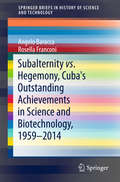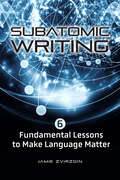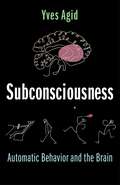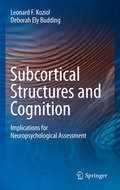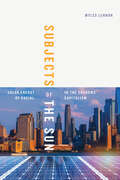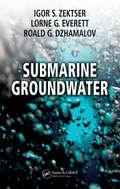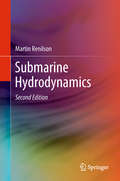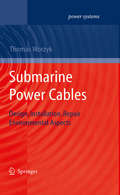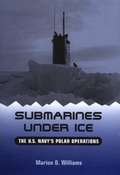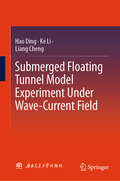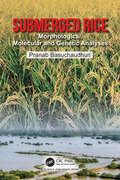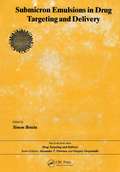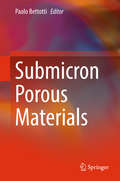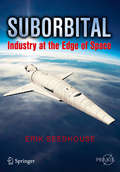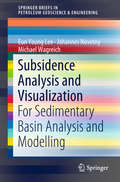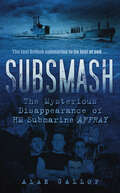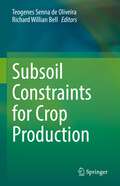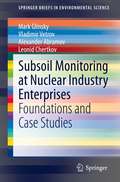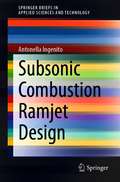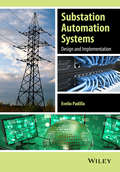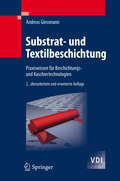- Table View
- List View
Subalternity vs. Hegemony, Cuba's Outstanding Achievements in Science and Biotechnology, 1959-2014
by Angelo Baracca Rosella FranconiThe present book introduces an original (new) perspective on Cuba. This book revisits Cuba's choice, after the 1959 revolution, to develop an advanced healthcare and scientific system. It also introduces new aspects of the problem development/underdevelopment. From the start, every effort of the Cuban leadership and scientific community was driven by the primary purpose of meeting the country's basic economic and social needs. Immediate key measures taken after the revolution included free education up to higher levels and free health services. In only a couple of decades Third World diseases were defeated and a First World health profile was achieved. In the sciences, support and collaboration was sought and welcomed from both Soviet and western countries. Moreover, due to the backward position of the Soviet Union in genetics and molecular biology, in the early 1970s Cuban scientists were trained in these fields mainly by Italian biologists. In the following decade, initially relying on contacts with American and Finnish specialists, Cuban biologists and physicians built a large industrial biotechnology complex to produce and commercialize Cuban-made, and often invented, medicines and vaccines. In the early 1990s the sudden collapse of the Soviet Union and the socialist market created an unprecedented challenge. Yet Cuba's scientific system substantially resiled, despite unavoidable setbacks. This crisis was faced by confirming and reinforcing government support for biotechnology, with the result that today Cuba excels at a global level in the typical capital-intensive field of biotechnology. While this book is especially devoted to historians of science and technology and to biotechnologists, it is of interest to the general public.
Subatomic Writing: Six Fundamental Lessons to Make Language Matter
by Jamie ZvirzdinSee science writing fundamentals afresh through a subatomic lens!In Subatomic Writing, Johns Hopkins University instructor Jamie Zvirzdin goes bravely into uncharted territory by offering a totally new kind of guide for writing about science—from the subatomic level up! Subatomic Writing teaches readers that the building blocks of language are like particles in physics. These particles, combined and arranged, form something greater than their parts: all matter in the literary universe. The six levels of language covered in this guide create writing that illuminates and energizes the reader to feel, learn, change, and act. This interdisciplinary approach helps scientists, science writers, and editors improve their writing in fundamental areas as they build from the sounds in a word to the pacing of a paragraph. These areas include• Sound and sense• Word classes• Grammar and syntax• Punctuation• Rhythm and emphasis• Pacing and coherenceEqually helpful for students who need to learn how to write clearly about science and scientists who need to hone their writing skills to create more effective course material, papers, and grant applications, this guide builds confidence in writing abilities as old skills are taught in new, exciting ways. Each lesson provides exercises that build on each other, strengthening readers' capacity to communicate ideas and data, all while learning basic particle physics along the way.
Subconsciousness: Automatic Behavior and the Brain
by Yves AgidWe are conscious of only a small fraction of our lives. Because the brain constantly receives an enormous quantity of information, we need to be able to do things without thinking about them—to act in “autopilot” mode. Automatic behaviors—the vast majority of our activities—occur without our conscious awareness, or subconsciously. Yet the physiological basis of subconsciousness remains poorly understood, despite its vast importance for physical and mental health.The neurodegenerative disease expert Yves Agid offers a groundbreaking and accessible account of subconsciousness and its significance. He pinpoints the basal ganglia—the ancient “basement of the brain”—as the main physiological hub of the subconscious. Agid examines its roles in the control and production of automatic behavior, including motor, intellectual, and emotional processes. He highlights the consequences for various brain pathologies, showing how malfunctions of the subconscious have clinical repercussions including not only abnormal involuntary movements, as seen in Parkinson’s disease, but also psychiatric disorders such as obsessive-compulsive disorders and depression. Based on this understanding, Agid considers how seeing the basal ganglia as a therapeutic target can aid development of potential new treatments for neurological and psychiatric disorders.Shedding new light on the physiological bases of our behavior and mental states, this book provides an innovative exploration of the complexities of the mind, with implications ranging from clinical applications to philosophy’s thorniest problems.
Subcortical Structures and Cognition
by Leonard F. Koziol Deborah Ely BuddingClinical psychologists and neuropsychologists are traditionally taught that cognition is mediated by the cortex and that subcortical brain regions mediate the coordination of movement. However, this argument can easily be challenged based upon the anatomic organization of the brain. The relationship between the prefrontal cortex/frontal lobes and basal ganglia is characterized by loops from these anterior brain regions to the striatum, the globus pallidus, and the thalamus, and then back to the frontal cortex. There is also a cerebrocerebellar system defined by projections from the cerebral cortex to the pontine nuclei, to the cerebellar cortex and deep cerebellar nuclei, to the red nucleus and then back to thalamus and cerebral cortex, including all regions of the frontal lobes. Therefore, both the cortical-striatal and cortical-cerebellar projections are anatomically defined as re-entrant systems that are obviously in a position to influence not only motor behavior, but also cognition and affect. This represents overwhelming evidence based upon neuroanatomy alone that subcortical regions play a role in cognition. The first half of this book defines the functional neuroanatomy of cortical-subcortical circuitries and establishes that since structure is related to function, what the basal ganglia and cerebellum do for movement they also do for cognition and emotion. The second half of the book examines neuropsychological assessment. Patients with lesions restricted to the cerebellum and/or basal ganglia have been described as exhibiting a variety of cognitive deficits on neuropsychological tests. Numerous investigations have demonstrated that higher-level cognitive functions such as attention, executive functioning, language, visuospatial processing, and learning and memory are affected by subcortical pathologies. There is also considerable evidence that the basal ganglia and cerebellum play a critical role in the regulation of affect and emotion. These brain regions are an integral part of the brain's executive system. The ability to apply new methodologies clinically is essential in the evaluation of disorders with subcortical pathology, including various developmental disorders (broadly defined to include learning disorders and certain psychiatric conditions), for the purpose of gaining greater understanding of these conditions and developing appropriate methodologies for treatment. The book is organized around three sources of evidence: neuroanatomical connections; patients with various disease processes; experimental studies, including various imaging techniques. These three sources of data present compelling evidence that the basal ganglia and cerebellum are involved in cognition, affect, and emotion. The question is no longer if these subcortical regions are involved in these processes, but instead, how they are involved. The book is also organized around two basic concepts: (1) the functional neuroanatomy of the basal ganglia and the cerebellum; and (2) how this relates to behavior and neuropsychological testing. Cognitive neuroscience is entering a new era as we recognize the roles of subcortical structures in the modulation of cognition. The fields of neuropsychology, cognitive psychology, neuropsychiatry, and neurology are all developing in the direction of understanding the roles of subcortical structures in behavior. This book is informative while defining the need and direction for new paradigms and methodologies for neuropsychological assessment.
Subject Seven
by Moore James A.Years ago, scientists began developing the ultimate military weapon: deadly sleeper assassins housed within the bodies of teenagers. Now, Subject Seven, the dangerous alter-ego living inside a 16-year-old boy, has escaped the lab and is on a mission. His objective? To seek out others like him and build an army capable of destroying their creators. Hunter, Cody, Gene, Tina, and Kylie: five teenagers leading typical lives, until the day they each receive a call from a mysterious stranger-and learn that their destinies are intertwined. Subject Seven holds the key that connects them all. And a vicious, bloody battle for their lives is just beginning.
Subjectivism in Economics and Philosophy: Re-orientating Economic Theory
by Karl MittermaierAvailable open access digitally under CC-BY-NC-ND licence. Following on from The Hand Behind the Invisible Hand and A Realist Philosophy of Economics, this new book drawn from Karl Mittermaier’s writings examines the intricate relationship between economic theory and real-world economic experiences. Despite the centrality of subjectivism in both philosophy and economics, these fields have often overlooked each other's insights. Mittermaier challenges this disconnect, advocating for a shift from deterministic models to a more reflective approach in economics. He examines the historical, methodological and philosophical dimensions of economic theory, highlighting its struggle to connect economic theory to empirical data and individuals' lived experiences. Originally penned between 1979 and 1982 and now published posthumously, this work remains a crucial contribution to contemporary economic discussions.
Subjects of the Sun: Solar Energy in the Shadows of Racial Capitalism (Elements)
by Myles LennonIn the face of accelerating climate change, anticapitalist environmental justice activists and elite tech corporations increasingly see eye to eye. Both envision solar-powered futures where renewable energy redresses gentrification, systemic racism, and underemployment. However, as Myles Lennon argues in Subjects of the Sun, solar power is no less likely to exploit marginalized communities than dirtier forms of energy. Drawing from ethnographic research on clean energy corporations and community solar campaigns in New York City, Lennon argues that both groups overlook solar’s extractive underside because they primarily experience energy from the sun in the virtual world of the cloud. He shows how the material properties of solar technology—its shiny surfaces, decentralized spatiality, and modularity—work closely with images, digital platforms, and quantitative graphics to shape utopic visions in which renewable energy can eradicate the constitutive tensions of racial capitalism. As a corrective to this virtual world, Lennon calls for an equitable energy transition that centers the senses and sensibilities neglected by screenwork: one’s haptic care for their local environment; the full-bodied feel of infrastructural labor; and the sublime affect of the sun.
Sublime Dreams of Living Machines: The Automaton in the European Imagination
by Minsoo KangFrom the dawn of European civilization to the twentieth century, the automaton—better known today as the robot—has captured the Western imagination and provided a vital lens into the nature of humanity. Historian Minsoo Kang argues that to properly understand the human-as-machine and the human-as-fundamentally-different-from-machine, we must trace the origins of these ideas and examine how they were transformed by intellectual, cultural, and artistic appearances of the automaton throughout the history of the West. Kang tracks the first appearance of the automaton in ancient myths through the medieval and Renaissance periods, marks the proliferation of the automaton as a central intellectual concept in the Scientific Revolution and the subsequent backlash during the Enlightenment, and details appearances in Romantic literature and the introduction of the living machine in the Industrial Age. He concludes with a reflection on the destructive confrontation between humanity and machinery in the modern era and the reverberations of the humanity-machinery theme today. Sublime Dreams of Living Machines is an ambitious historical exploration and, at heart, an attempt to fully elucidate the rich and varied ways we have utilized our most uncanny creations to explore essential questions about ourselves.
Submarine Groundwater
by Igor S. Zektser Lorne G. Everett Roald G. DzhamalovSustainable management of water resources is quickly increasing in importance on a global scale. An important piece of the puzzle is the characterization of marine water and determining its importance to geochemical budgets. To do this, submarine groundwater discharges must be carefully studied. Comprehensively exploring the subject, Submarine G
Submarine Hydrodynamics (SpringerBriefs in Applied Sciences and Technology)
by Martin RenilsonThis book covers specific aspects of submarine hydrodynamics in a very practical manner. The author reviews basic concepts of ship hydrodynamics and goes on to show how they are applied to submarines, including a look at the use of physical model experiments. The book is intended for professionals working in submarine hydrodynamics, as well as for advanced students in the field.This revised edition includes updated information on empirical methods for predicting the hydrodynamic manoeuvring coefficients, and for predicting the resistance of a submarine. It also includes new material on how to assess propulsors, and includes measures of wake distortion, which has a detrimental influence on propulsor performance. Additional information on safe manoeuvring envelopes is also provided. The wide range of references has been updated to include the latest material in the field.
Submarine Power Cables
by Thomas WorzykThe demand for high-performance submarine power cables is increasing as more and more offshore wind parks are installed, and the national electric grids are interconnected. Submarine power cables are installed for the highest voltages and power to transport electric energy under the sea between islands, countries and even continents. The installation and operation of submarine power cables is much different from land cables. Still, in most textbooks on electrical power systems, information on submarine cables is scarce. This book is closing the gap. Different species of submarine power cables and their application are explained. Students and electric engineers learn on the electric and mechanic properties of submarine cables. Project developers and utility managers will gain useful information on the necessary marine activities such as pre-laying survey, cable lay vessels, guard boats etc., for the submarine cable installation and repair. Investors and decision makers will find an overview on environmental aspects of submarine power cables. A comprehensive reference list is given for those who want further reading.
Submarines under Ice: The U.S. Navy's Polar Operations
by Marion D. WilliamsThe author beautifully depicts the 1931 submarine expedition of Sir Hubert Wilkins to explore the Arctic Ocean. The book also shows the rapid advance of science and technology in submarines.
Submerged Floating Tunnel Model Experiment Under Wave-Current Field
by Liang Cheng Ke Li Hao DingThis book conducts research on the overall design of the submerged floating tunnel, structural safety standards, environmental load calculation methods, pipe structure selection, joint structure form, anchoring mode, collision avoidance technology, operation ventilation and disaster prevention, etc., and proposes a preliminary engineering technical plan for the submerged floating tunnel in Qiongzhou Strait. It focuses on the domestic and foreign research status of submerged floating tunnels, model experiment theory and method, experimental system, model design, experimental process, experimental results analysis, and other unique achievements and thoughts. This book is suitable for tunnel engineering scientists, tunnel engineering designers, civil engineers, traffic planning designers, civil engineering students, and teachers. Because submerged floating tunnel is a kind of tunnel structure full of innovation and challenge, research results on suspended tunnels are relatively rare. This book includes the design scheme of submerged floating tunnel, model experiment theory, experimental system, analysis of experimental results, etc., which can provide ideas for the current design of submerged floating tunnel, and also provides useful reference for scholars engaged in the research of basic theory and key technology of submerged floating tunnel and related fields.
Submerged Rice: Morphological, Molecular and Genetic Analyses
by Pranab BasuchaudhuriWater stagnation and submergence are major factors in rice growing. Water stagnation and submergence happen as a result of excessive rainfall or flash floods. The duration of submergence can last several weeks, and the level of water may be as high as 100 cm. This impacts rice yields. This book analyzes different aspects, viz., morphology, physiology, biochemistry and genetics, and reviews the suitability of different varieties for better sustainability and reduction of yield loss. It also reviews the different types of floods, and studies biological changes in indigenous and recently developed rice varieties. There are seven chapters: Introduction, History of floods, Diversity of submergence, Adoptive morphology, Physiological aspects, Molecular and genetic aspects, and Yield and yield-gaps. It is comprehensive with scientific dogma, findings and reasonings for students at universities and researchers.
Submicron Emulsions in Drug Targeting and Delivery
by Simon BenitaIt is anticipated that submicron emulsion and lipid suspension will find numerous and novel medical applications in the near future. The purpose of this multi-authore book is to provide the reader with an up-to-date general overview of submicron emulsions and lipid suspensions (solid lipid nanoparticles) as well as to emphasize the various methods of preparation, characerization, evaluation and potential applications in various therapeutic areas.Leading authors have contributed to this unique book which contains all state of the art and detailed knowledge related to the physico-chemical, pharmaceutical and medical aspects of these most interesting but complex dosage forms, thus making this information easily available to the reader. This book will be of interest to scientists working in the field of drug delivery and targeting in universities as well as in the pharmaceutical, food, cosmetic, veterinary and chemical industries.
Submicron Porous Materials
by Paolo BettottiThis book covers the latest research on porous materials at the submicron scale and inspires readers to better understand the porosity of materials, as well as to develop innovative new materials. A comprehensive range of materials are covered, including carbon-based and organic-based porous materials, porous anodic alumina, silica, and titania-based sol-gel materials. The fabrication, characterization, and applications of these materials are all explored, with applications ranging from sensors, thermoelectrics, catalysis, energy storage, to photovoltaics. Also of practical use for readers are chapters that describe the basics of porous silicon fabrication and its use in optical sensing and drug delivery applications; how thermal transport is affected in porous materials; how to model diffusion in porous materials; and a unique chapter on an innovative spectroscopic technique used to characterize materials' porosity. This is an ideal book for graduate students, researchers, and professionals who work with porous materials.
Suborbital
by Erik SeedhouseThe nascent commercial suborbital spaceflight industry will soon open the space frontier to commercial astronauts, payload specialists, scientists and of course, tourists. This book describes the tantalizing science opportunities to be offered when suborbital trips become routine within the next 12 to 18 months. It describes the difference in training and qualification necessary to become either a spaceflight participant or a fully-fledged commercial suborbital astronaut and it describes the vehicles this new class of astronauts will use. Anticipation is on the rise for the new crop of commercial suborbital spaceships that will serve the scientific and educational market. These reusable rocket-propelled vehicles are expected to offer quick, routine and affordable access to the edge of space along with the capability to carry research and educational crew members. Yet to be demonstrated is the hoped-for flight rates of suborbital vehicles. Quick turnaround of these craft is central to realizing the profit-making potential of repeated sojourns to suborbital heights. As this book outlines, vehicle builders still face rigorous shake-out schedules, flight safety hurdles as well as extensive trial-runs of their respective craft before suborbital space jaunts become commonplace. The book examines some of these 'cash and carry' suborbital craft under development by such groups as Blue Origin, Masten Space Systems, Virgin Galactic and XCOR Aerospace and describes the hurdles the space industry is quickly overcoming en-route to the industry developing into a profitable economic entity. Seedhouse also explains how the commercial suborbital spaceflight industry is planning and preparing for the challenges of marketing and financing and how it is marketing the hiring of astronauts. It examines the role of commercial operators as enablers accessing the suborbital frontier and how a partnership with governments and the private sector will eventually permanently integrate the free market's innovation of commercial suborbital space activities.
Subsidence Analysis and Visualization: For Sedimentary Basin Analysis and Modelling (SpringerBriefs in Petroleum Geoscience & Engineering)
by Eun Young Lee Johannes Novotny Michael WagreichThis book provides a comprehensive introduction to techniques for quantitative subsidence analysis and visualization with example applications. Subsidence analysis is an essential step to understand basin evolution through geologic time and space in the study of sediments and sedimentary basins. Quantifying techniques have been developed and applied in many basin research projects to evaluate total, tectonic and thermal subsidence. They are also a pre-requisite for basin evolution modelling. Recent studies have applied visualization techniques to understand regional subsidence contexts and trends, which confirmed that three-dimensional visualization of the basin subsidence is highly helpful to gain insight into basin evolution. In this book, we show how geoscience and computer science can be effectively combined in advanced basin analysis, especially in terms of basin subsidence. Each type of subsidence analysis is introduced with example applications. In particular we present a study of the Vienna basin using BasinVis, a MATLAB-based program for analyzing and visualizing basin subsidence. Given its breadth of coverage, this book will benefit students in undergraduate and postgraduate courses and provide helpful information for research projects and industry applications.
Subsmash: The Mysterious Disappearance of HM Submarine Affray
by Alan GallopIn April 1951, the disappearance of HM submarine Affray knocked news of the Korean War and Festival of Britain from the front pages. Affray had put to sea on a routine peacetime simulated war patrol in the English Channel. She radioed her last position at 2115hrs on 16 April, 30 miles south of the Isle of Wight - preparing to dive. This was the last signal ever received from the submarine. After months of searching, divers eventually discovered Affray resting upright on the sea bottom with no obvious signs of damage to her hull. Hatches were closed tight and emergency buoys were still in their casings. It was obvious that whatever had caused Affray to sink, and had ended the lives of all those on board, had occurred quickly. Sixty years later, in this compelling maritime investigation, Alan Gallop uses previously top secret documents, interviews with experts and contemporary news sources to explore how and why Affray became the last British submarine lost at sea - and possibly the greatest maritime mystery since the Marie Celeste.
Subsoil Constraints for Crop Production
by Teogenes Senna de Oliveira Richard Willian BellThis book will address the major subsoil physical and chemical constraints and their implications to crop production; Plant growth is often restricted by adverse physical and chemical properties of subsoils yet these limitations are not revealed by testing surface soils and hence their significance in crop management is often overlooked. The major constraints can be physical or chemical. Physical limitations such as poor/nil subsoil structure, sandy subsoils that do not provide adequate water or gravelly subsoils and, etc. On the other hand, chemical constraints include acidity/alkalinity, high extractable Al or Mn, low nutrient availability, salts, boron toxicity and pyritic subsoils. Some of these constraints are inherent properties of the soil profile while others are induced by crop and soil management practices. This aim of this book is to define the constraints and discuss amelioration practices and benefits for crop production. This book will be of interest to readers involved with agriculture and soil sciences in laboratory, applied or classroom settings.
Subsoil Monitoring at Nuclear Industry Enterprises: Foundations and Case Studies (SpringerBriefs in Environmental Science)
by Mark Glinsky Vladimir Vetrov Alexander Abramov Leonid ChertkovThis book is the first comprehensive review of the subsurface monitoring theory and practice. It presents all aspects of a subsurface monitoring system SM-NI to be organized in impacted areas of nuclear industry enterprises. The content of the book covers the whole set of the SM-NI projecting and implementation issues – from the theoretical and regulatory framework, through the description of the sources of impact on geological environment to examples of use the SM-NI to solve environmental problems on the main types of environmentally significant nuclear industry enterprises. Development of the SM-NI was based on long-term research studies including modeling of pollutants transport in the geological environment.The book is intended for a wide range of nuclear industry employees and specialists in environment protection and radiation safety of nuclear industry enterprises. It might be useful for ecologists, students and postgraduates concerned about environment protection in the field of nuclear technology
Subsonic Combustion Ramjet Design (SpringerBriefs in Applied Sciences and Technology)
by Antonella IngenitoThis book presents a step-by-step methodology for the design of ramjet engines. It explores ramjet combustion, provides guidelines on how to size the engines, and discusses performance analysis. The book begins with an introduction to ramjet design, including fundamental definitions in the field. It then discusses ramjet engine performance, and fuels which can be used. Several types of ramjet engines are then explored, and guidelines for their design are presented, including flame holders, injectors, and combustors. Finally, the book concludes with a discussion of the types of materials which should be used for ramjet engines. This book is of interest to engine designers and engineers, researchers, and graduate students, as it collates research in a succinct, clear guide to the issue of designing ramjet engines.
Substation Automation Systems
by Evelio PadillaSubstation Automation Systems: Design and Implementation aims to close the gap created by fast changing technologies impacting on a series of legacy principles related to how substation secondary systems are conceived and implemented. It is intended to help those who have to define and implement SAS, whilst also conforming to the current industry best practice standards. Key features: Project-oriented approach to all practical aspects of SAS design and project development. Uniquely focusses on the rapidly changing control aspect of substation design, using novel communication technologies and IEDs (Intelligent Electronic Devices). Covers the complete chain of SAS components and related equipment instead of purely concentrating on intelligent electronic devices and communication networks. Discusses control and monitoring facilities for auxiliary power systems. Contributes significantly to the understanding of the standard IEC 61850, which is viewed as a "black box" for a significant number of professionals around the world. Explains standard IEC 61850 - Communication networks and systems for power utility automation - to support all new systems networked to perform control, monitoring, automation, metering and protection functions. Written for practical application, this book is a valuable resource for professionals operating within different SAS project stages including the: specification process; contracting process; design and engineering process; integration process; testing process and the operation and maintenance process.
Substrat- und Textilbeschichtung
by Andreas GiessmannDas Buch liefert einen Überblick über Verfahren und Technologien der Beschichtungs- und Kaschierindustrie, die insbesondere bei der Herstellung technischer Textilien zum Einsatz kommen. Der Autor behandelt unterschiedliche Substrate und Beschichtungsmassen, die Verfahrenstechnik sowie Anlagen und Anlagenkomponenten. In der 2. Auflage werden neue, verbesserte Trocknungssysteme sowie die Beschichtung medizinischer Produkte beschrieben. Ferner wurde die aktuelle Auflage um ein Kapitel zur Anwendung von Plastisolen und Additiven ergänzt.
Substrat- und Textilbeschichtung: Praxiswissen für Beschichtungs- und Kaschiertechnologien (VDI-Buch)
by Andreas GiessmannDas Buch liefert einen Überblick über Verfahren und Technologien der Beschichtungs- und Kaschierindustrie, die insbesondere bei der Herstellung technischer Textilien zum Einsatz kommen. Der Autor behandelt unterschiedliche Substrate und Beschichtungsmassen, die Verfahrenstechnik sowie Anlagen und Anlagenkomponenten. In der 2. Auflage werden neue, verbesserte Trocknungssysteme sowie die Beschichtung medizinischer Produkte beschrieben. Ferner wurde die aktuelle Auflage um ein Kapitel zur Anwendung von Plastisolen und Additiven ergänzt.
